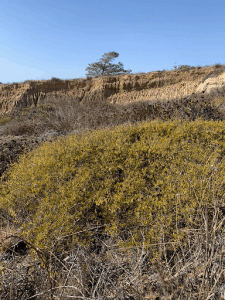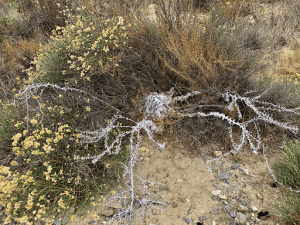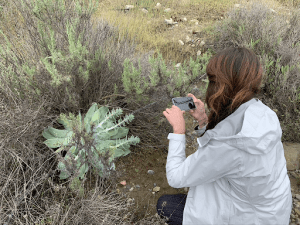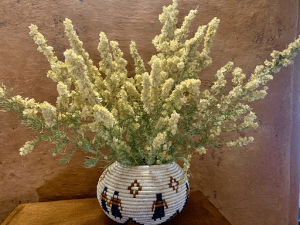November in the Natural Garden

A fall day in Torrey Pines State Natural Reserve.
The best things in life are worth waiting for. Now Fall 2020 has finally come into our lives.
Spring was weird, Covid confusion ruling the day. Summer was brutal, especially the latter days, when heatwave and fire ravaged us all. It seemed as if post summer (September) would never end, with smoky skies and a relentless badgering on all things wild and natural. October rang in with a little hope; shorter days, cooler nights, then a big bizarre wind, and at last a few signs of seasonal change. And now November. We’ve been waiting. You have been a long time coming.
Current events, history, review, and notes
With colors crisply defined every morning and long afternoon shadows, and we are reminded of a cold quiet time on the horizon. I guess every fall we wonder, “Will we get good rains this winter?” California is fickle that way. And on arrival of the first, we gardeners (always optimistic) sense that the gates have surely been opened for more storms to pour through, feeling cheerful and comforted that all will be well through April. In the years when the weather in fact turns windy and dry, and the cold ground gasps for any dampness, we chalk it up to a “dry winter” and move on, hoping for a wet spring. We hope. Bring on November, bring on hope.
For everyone who loves puttering around in the garden, working through our monthly newsletter, and checking all these tasks off their to-do list, know this: In November you can do no harm. Feel free to water, prune, weed, mulch, feed, troubleshoot, plant seed, plant new plants and engage to your heart’s desire.
In the other months of the year, some tasks, performed untimely, will harm the plants or the garden. A well-intentioned watering during a heat wave in August would likely be the doom of a Catalina ironwood, Fremontia, Pacific wax myrtle, manzanita, or monkey flower. Cutting back a ceanothus in April would ruin its bloom, or in August might cause the branches to sunburn. Feeding your sage, buckwheat, sunflower, sagebrush combo in summer would cause unnatural new growth making it vulnerable to insect and fungal disease problems. Garden smart. Have fun. If timing is everything, this is the time for it.
Four wing saltbush (Atriplex canescens), dry arrangement in a lovely Seri basket.
Watering
Watch the weather forecasts. A real rain is anything over half an inch, preferably a series of half-inch showers that add up to a two-inch event, just like our Deep Soak explained here in September in the Natural Garden 2020 and our Watering Guide. Don’t be fooled by light rain, heavy mist, drizzle, or fog. Roots do not benefit from such. Those moisture events are more like the Refreshing Sprinkles defined and referenced in the links above.
Related to Watering
Since native plants are adapted to cool season moisture with cooler soil temps providing a safe place for roots, you can water a little more frequently than the recommended once every three to four weeks and use less water each time. In the absence of real rain, try maintaining consistent soil moisture by running the sprinklers about 15-20 minutes once every week or ten days. You’ll still be applying a cumulative amount of one to two inches per month.
Pruning
Please see last month’s newsletter, for in-depth coverage on this topic. Like last month, November is a good time for this.
Weeding
You may see the emergence of the first crop of weeds from seeds with your initial cool season irrigations. If they are still young and tiny, you can smother them with a healthy 2” layer of high quality chunky (ground bark) organic mulch, or 1” layer of mineral top dress, i.e.; decomposed granite or pebble aggregates.
Mulching/Top dress
We repeat, the best top dress for your garden will always be the natural leaf litter, forest duff, or “mulch” that the plants make themselves, as they drop organic matter onto the soil surface around their root zones. This month you can import mulch of a foreign source but be careful. No weed seed, no disease and no inferior materials. Organic mulch should have no foul odor, no paint or dyes, and no splinters. Texture and make-up are everything. Avoid any organic product where you can identify all of the following in the mulch; sticks, strings, flakes and dust. It will bind up and form an impenetrable mat. Always choose chunks, such as redwood or cedar bark. You can make your own sustainable lightweight top dress by running autumn tree leaves through a leaf shredder. The end product will be flakes, suitable for a seasonal top dress.
Mineral mulch is quite nice in natural gardens. Experiment in small areas with decomposed granite or attractive natural pebble aggregates. These top dress layers need only be about 1” thick. You can peruse many different materials at your local building supply. Do not use any weed fabric or so-called breathable landscape fabric under any mulch in planted areas.
For a truly unique and natural look, use different top dress components in drifts to achieve a “look” that helps tell the story of your garden. Remember to leave some bare earth for the ground nesting native pollinator bee species.
Feeding
Fall is for feeding. Organic fertilizers provide a steady supply of plant nutrients and tend to improve soil biology by promoting microbial action. Chemical fertilizers provide plant nutrients quickly and may leave some residual salts behind. Slow-release chemical fertilizers are formulated to provide plant nutrients over a 3-6 month period as the tiny time capsules slowly dissolve. The problem with most slow-release is that we want to feed our native plants in the cool season, and the slow-release prills need both warm soil temps and moisture to spring into action. They work well for irrigated tropical plants that grow in summer.
Our preference for natural gardens is organic fertilizer. We like a balanced blend, usually formulated for vegetables and fruit trees, providing nitrogen, phosphorus, and potassium (N-P-K, the three percentage numbers on the bag), plus as many micronutrients (i.e.; iron, magnesium, zinc, etc.) as possible. Follow instructions on the bag, or use slightly less, as natives are super efficient on nutrient uptake. See October 2020 for more information.
 Bush rue (Cneoriduim dumosum) normally sports bright green leaves. Here at Torrey Pines, this one is telling us about a long dry period to date, and is presently hoping for rain.
Bush rue (Cneoriduim dumosum) normally sports bright green leaves. Here at Torrey Pines, this one is telling us about a long dry period to date, and is presently hoping for rain.
Troubleshooting – Varmints, Pests and Diseases
With dry conditions still present before our anticipated wet season, the biggest problem in most gardens this month is Argentine ants. These ubiquitous pests are bothersome everywhere including at picnics and in kitchens and pantries, and are harmful in the garden because they transport, protect, tend, and receive benefit from harmful plant pests like aphid, scale and mealybug. In addition, their tunnels and nests can undermine a plant’s root ball and cause the plant to desiccate. They have no native predators and they are quite capable of eliminating the good guy native ant species wherever their populations are strong. They are basically one clone, so they don’t even fight each other over territory. Evil.
In season, they “farm” aphid, scale, and mealybug, tiny insects that feed on plant juices with their sucking mouthparts, establishing a sort of “free range ranchito” on your plants’ branches and leaves (even roots in the case of mealybug). The ants feed off the excrement, a sweet liquid called honeydew, as the bad guys keep multiplying and sucking and excreting. The ants actually tend to their “herds” protecting them, moving them around to fresh green pasture, and eating the honeydew. In summer, you may have seen small black stains, sticky spots called sooty mold on your plants, the sidewalk, rocks, or anywhere where honeydew falls and remains long enough for the mold to grow.
If you can control ants now, it will be easier to control injurious plant pests next spring. You can try flooding the nests with a steady stream of water from the hose, or use growth regulating hormones like Combat which, when applied correctly and carried back to the nest by the workers will kill the queen causing the colony to collapse. Contact poisons (sprays like Raid) while momentarily providing you great satisfaction as the ants instantly curl up dead, will not even put a dent in the permanent problem. When using any insecticide, always follow directions on the label.
A lot of other insects will be entering a dormant stage in winter. If you experienced Ceanothus stem gall moth problems last spring/summer, you may want to thoroughly clean up around your ceanothus plants, removing the dead leaves and other vegetative matter that has accumulated. This will eliminate most of the grubs and pupae that will emerge as adults next year when the plants are in flower. The same is true under toyon where you might have seen a lot of fungal leaf spot or branch dieback last summer. Get the dead leaves out of there, as the disease harbors through winter in the leaf mulch.
As always, feel free to contact me with any specific questions or concerns.
Annual Wildflowers
You can get ready to sow wildflower seed any day now. Technically you can do it anytime this month, but to be sure your seed will quickly come in direct contact with moist soil, try to time the sowing for a day or so before a forecasted rain. Scratch up the soil surface about 1/2” deep. Mix the seed with a little organic mulch (bulk it up) to make it easier to apply uniformly. From a bucket or bag, grab handfuls and toss it around as if you are feeding the chickens? Never fed chickens? It’s kinda like sowing wild flower seed, except you say “Here chick chick chick chick chick, heeeere chick, chick, chick,” for the chickens. Calculate your rate so that the seeds fall approximately one inch apart. We have several custom native seed mixes available at the store or you can order, and we will ship them to you. See wildflower seeds here.
Adding New Plants
As is true with every horticultural task discussed above, introducing new plants to your garden is easily accomplished in November. The soils are cool, rains are just around the corner (we hope), and the pleasant days remaining until winter will give the plants a fine little boost of new growth.
 Chalk dudleya (Dudleya pulvuralenta) ready for rain in Novemeber 2020.
Chalk dudleya (Dudleya pulvuralenta) ready for rain in Novemeber 2020.
 Chalk dudleya, same plant in March, 2020
Chalk dudleya, same plant in March, 2020
Engage
At every level, nature heals. Emersion, engagement, connection, interaction, involvement, and even reading or thinking about the beauty of the natural world will soothe the soul. When you combine the incomparable attributes of nature with the hands-on occupation of active horticulture in your natural garden, you get a double dose of restorative medicine. Those special times spent performing any and all of the jobs described above provide valuable therapy for you and notable well being for your garden.
November in the natural garden should get you dreaming about March. You may be pruning drought stressed branches today, but in doing so you can be dreaming about blooms and butterflies and flower arrangements and hummingbirds and spring showers and the arrival of birds, the ones who have just left.
November lies at the start of a garden path leading to March. Follow the markers, set up a couple cairns for others along the way, pause frequently to take in the scenery, and mark your progress. The best hikers remember to occasionally glance back, familiarizing themselves for the return journey, or in case they were to get lost and have to backtrack.
Seasons in the garden click by and we move on. But there’s always the hope of November. Every year.
Hey, we’re makin’ it!
From the Garden,
Mike Evans
Questions? Help is just one call or one email away. Call (949) 728-0685 or email (with pictures if you like) our special helpline: gardenhelp@californianativeplants.com
To get our monthly updates sign up for our eNewsletter at this link here.
